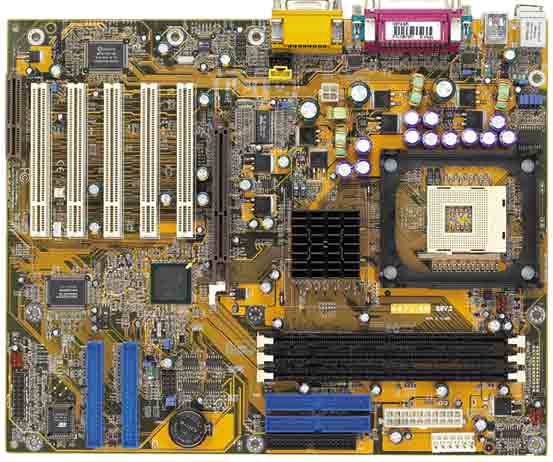The Layout
The NB72 offers average
expansion for an 845 solution. It features a standard AGP 4X slot, five PCI
and one CNR slot. Three memory banks are available for memory expansion.
DFI opted to take advantage
of the implanted AC'97 sound present on the ICH2. This particular codec is
very similar to the Sound-Blaster 16 card and should satisfy most of the users.
However, if you own a quality surround speaker set and are playing a lot of
games featuring multi channel support, you would be better off with a normal
high-end audio card such as the Creative Sound Blaster Live. The implanted
audio solution features two internal audio connectors (CD-in/AUX in) on the
PCB.

The memory slots are conveniently located as to not disturb the layout of
the rest of the board nor do they interfere with the AGP graphics card once
inserted; a little problem that has been noticed on several mainboards on
today's market. The two main IDE and the floppy connector are comfortably
positioned behind the memory slots. The ATX power connector is placed just
above the IDE connectors; we would have appreciated to see this located near
the internal audio inputs of the board in order to avoid having cables block
the air flow of the CPU.
One weakness we found
is the placement of the two IDE RAID connectors; they are placed behind two
PCI slots, this could result in unpleasant experiences with IDE cables and
PCI cards. The board features a total of 3 fan connectors. Two of them are
located at the top; one close to the CPU socket and the other after the third
DIMM slot. The third one is located at the very bottom along with the ATX
Case connectors.
The NB72 features hardware
RAID support via the well known Promise controller. You can see the Promise
chip just above the two IDE RAID connectors. RAID 0 and RAID 1 is supported
in hardware.
Overclocking
Overcloking your Pentium 4 on the NB72 will somewhat be limited. While
the board offers 1 MHz increasements for the processor's front side bus, no
voltage regulation support is present.
